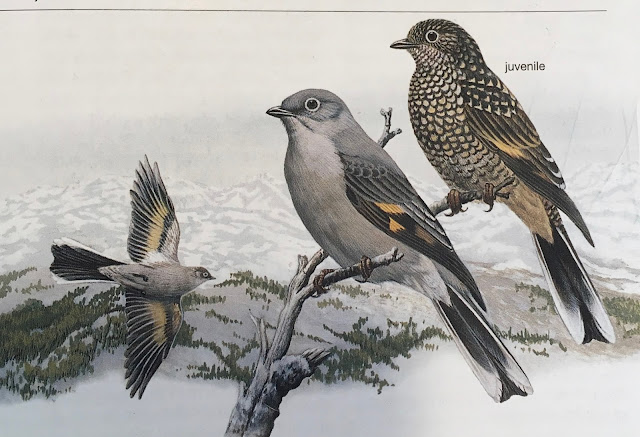North America's Rarest Falcon Seen in Nova Scotia
 |
| Gyrfalcon - Dark Morph - Juvenile [Jason Dain Photo] |
The Gyrfalcon is a very rare winter resident and migrant to Atlantic Canada. For the last few days there has been one reported from the River Hebert area, near Joggins, NS. This bird was seen and photographed by several birders on Tuesday, Feb. 21, 2017. A big 'thank you' goes out to both Jason Dain and Carmella Melanson for the use of their photos. These are prized images which provide a great educational opportunity for birders, environmentalists, and general nature lovers.
The Gyrfalcon is the world's largest falcon. It is 51-64 cm long (20-25 in). For comparison, the Peregrine Falcon is 41-51 cm long (16-20 in). The Gyrfalcon sits upright often on manmade structures or cliff edges, presumably watching for prey. It is a super hunter, capable of taking down flying geese or cranes. Here it would probably be feeding on waterfowl or pigeons. Its colour is variable. It occurs in three colour morphs; white, gray and dark; sometimes listed as white, intermediate and dark. Genders are similar but juveniles are a bit different. As in most raptors, females are larger.
The Gyrfalcon is a large, bulky falcon. It is not as sleek looking as our other falcons (kestrel, merlin, peregrine falcon). Its wings are wide at the base and pointed. In flight the tail base looks wide and the tail is longer than that of the peregrine falcon. When perched the wings extend about 2/3 of the way down the tail length. In flight its wing beat appears slow but don't be fooled. This bird is a very fast killing machine.
The dark morph is dark gray to gray-brown on the back and wings with heavy striping on the breast and underneath. The gray morph is similar to the dark morph but much lighter overall. The white morph is all white with dark wing tips and streaks mainly on the upper body parts. Underneath all morphs show lighter trailing edges of the wings and darker wing coverts. See photo below.
 |
| Gyrfalcon - Dark Morph - Juvenile [Jason Dain Photo] |
The adult Gyrfalcon shows yellow on the cere (base of bill), feet and around the eye. In the juvenile, these features are gray.
 |
| Adult Gyrfalcon [Icelandic Bird Guide, Hilmarsson, JO, p. 106] |
The Gyrfalcon has been a famous hawk since medieval times when it was the most desired species for falconry. Only kings were allowed to use this species. Unfortunately, falconry is still going on today and these birds are being captured and kept in captivity for this purpose.
The Gyrfalcon is a holarctic species. In North America it is a year-round resident of Alaska, northern Yukon, Nunavit and Northwest Territories, Ungava, north to our northernmost islands. It is rare south of these areas, usually coming south in winter. We have records for New Brunswick for 1989, 1991, 1994, 2000. I have been lucky enough to have seen 2 gray morphs in Iceland and a white morph here in New Brunswick.
 |
| Gyrfalcon [Carmella Melanson Photo] |
 |
| Gyrfalcon [Carmella Melanson Photo] |
Gyrfalcons nest on cliffs or in abandoned raven nests. Breeding occurs only in the far north.
All the photos shown (except the light gray morph taken from the Icelandic Bird Guide) are of the same bird now present somewhere in Nova Scotia. It is possible this bird will stay around for a few days yet. We were unable to locate it yesterday. We wish it well as it soon journeys to the far north to breed.










